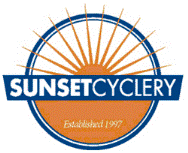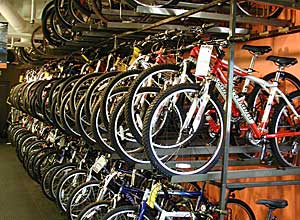|
Choosing A Bike There are so many styles and prices, what's right for you? |
|
You couldn't pick a better time to shop for a new bike. Today, a vast variety of models are offered in a wide array of prices. From super-plush comfort bikes to knobby tire mountain bikes; from thoroughbred road machines to robust cruisers, your local shop has two-wheelers perfect for just about everything.
So many attractive choices can be overwhelming. But, a large selection is a wonderful thing because it drastically increases the likelihood of finding the perfect bike. Plus, at the bicycle store, you'll be able to ask questions, learn about different bike types, even test a few. Just be sure to go in equipped with a little knowledge about yourself, the cycling you'd like to do and some basic information about bike models that have already caught your fancy. That way, you'll be able to answer the questions from the shop's staff and you'll get a bike you really enjoy. To help, we recommend a little self analysis (therapist not required).
Answer These Questions
Before visiting the showroom, define yourself a bit. Consider how you'll use the new bike and where you'll pedal once you've had it for a while. And ask yourself a few questions to figure out what type of bike is right. Are you:
Consider how many times a week or month you might ride. If you're new to biking, think about your other sports experiences. Did you participate mostly for fun or did you take it seriously? Your tendencies can tip you off as to whether you'll be satisfied with a basic model or whether you'll need something better that your enthusiasm won't outgrow.
Think about your tendencies in purchasing other things, too. For example, do you consistently demand the highest quality, or are you more apt to look for reasonable quality and lower cost? Do you dig high-tech gadgets or are you satisfied with simpler designs? If you're joining a cycling club, will you want a bike that outshines all the others? Or will any two-wheeler that does the job be just fine?
Where you live plays a major role in what type of bike to get. You'll ride more if your new machine matches your riding opportunities. For example, if you're surrounded by beautiful trails, an off-road bike might be a better choice than a pavement pounder (assuming you don't also have great road rides, in which case, you might need two bikes!).
Mind Your Budget
Additionally, it helps to know about how much you want to spend because that's a quick way to focus the selection process on the appropriate models. Like computers and other modern appliances, it's best (and cheapest) to purchase the most appropriate model at the outset than to gamble on a make-do bike and buy another later. Regardless of the type, as you spend more, bicycles get slightly lighter (easier to ride) and are equipped with more features and more efficient components.
While it's always possible to upgrade parts down the road, bike components are much more affordable when they're included as standard equipment on the new bike. So, it's most economical to get what you want when you buy your new bike.
When calculating how much you'd like to spend on that new machine, remember that you may need some extras. Common purchases include helmets, locks, pumps, tool kits, cycling shorts and shoes. Figure these costs into the bike-purchase budget, too.
Bike Types
Here's a rundown of the six major bike types available today with descriptions of their intended use and common features. To help you get a feel for each type, we've assigned each the name of a famous place appropriate for the bike's personality (it's also a test of your imagination).
Use these descriptions to determine which type is right for you. If you're not sure, keep in mind that most bicycle shops offer test rides, which is an excellent way to see how types differ. You might also ask friends who ride if you can try their bikes. Ride both on and off road (on the appropriate models) to experience the difference.
Comfort Bikes (place: Hawaii)
USE: Designed for easy pedaling and the least amount of stress on the body, Comfort bikes are perfect for leisurely town riding, cruising by the shore, vacation outings and any ride where you're out more for fun than for speed.
COMMON FEATURES: Upright riding position; wide handlebars; wide, comfortable seats; flat-resistant tires; easy pedaling; soft ride.
Hybrid Bikes (Seattle)
USE: A hybrid of the mountain bike and the road bike, these practical machines are ideal for city riding, commuting, touring and fitness riding.
COMMON FEATURES: Upright riding position; flat handlebars; low gearing for easy hill climbing; powerful brakes; light, lively wheels with flat-resistant tires; load-carrying capacity.
Mountain Bikes (Colorado)
USE: Sometimes called All-Terrain Bikes (ATB) or Off-Road Bikes, these amazing vehicles could also be called Go-everywhere/Do-everything bikes. From cliff-like dropoffs to shoe-drenching stream crossings, almost no obstacle can stop a skilled rider.
COMMON FEATURES: Upright riding position; flat or riser handlebars; high-traction, flat-resistant tires; low gearing; excellent braking; rugged frames, wheels and components; suspension for control and comfort on rough terrain.
Road Sport Bikes (New England)
USE: Built for use on pavement, these models have plenty of get-up-and-go and are perfect for centuries, touring, longer commutes, fitness riding and pledge rides.
COMMON FEATURES: Efficient-pedaling lightweight frames and wheels; drop or flat handlebars; low gearing and excellent braking; narrow, high-pressure tires.
Road Racing Bikes (Italy)
USE: The ultimate in efficiency, these zippy models offer incredible acceleration and handling, ultralight (under 20-pound) weights and are perfect for those who ride fast and hard on pavement.
COMMON FEATURES: The most efficient frames; lightweight materials throughout; excellent braking and shifting (the gearing is usually most suited to ultra-fit cyclists); narrow, high-pressure tires; aero wheels.
Recumbents (Las Vegas)
USE: Resembling lawn chairs on wheels, these impressive and ultra-comfortable rigs are great for most road uses, including touring, commuting, fitness riding and pledge rides.
COMMON FEATURES: Unique frames that provide a comfy reclining riding position; seats with full support and backrests for amazing comfort; low gearing and excellent braking.
Cruisers (Florida)
USE: Rolling on soft "balloon" tires and equipped with comfy wide seats and handlebars, these models are great for leisurely spins to school, pedaling to the shore with your surfboard under your arm or just for coasting around the neighborhood.
COMMON FEATURES: Comfortable upright riding position; shock-absorbing fat tires; foot-friendly rubber pedals; sweet seat and spacious handlebars; usually feature from 1 to 7 speeds.
Now that you know a little more about yourself and your bicycle choices, you're ready to hit the shops. Enjoy selecting that new two-wheeler. Soon, you'll be spinnin' and grinnin' and feeling like a kid again.

